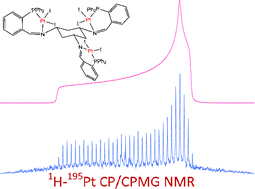Synthesis and solid-state characterization of platinum complexes with hexadentateamino- and iminophosphine ligands†
Abstract
![[double bond, length as m-dash]](https://www.rsc.org/images/entities/char_e001.gif) CHC6H4(PPh2))3 (1) and cis,cis-C6H9(NHCH2C6H4(PPh2))3 (2) were synthesized starting from
CHC6H4(PPh2))3 (1) and cis,cis-C6H9(NHCH2C6H4(PPh2))3 (2) were synthesized starting from

Maintenance work is planned for Wednesday 1st May 2024 from 9:00am to 11:00am (BST).
During this time, the performance of our website may be affected - searches may run slowly and some pages may be temporarily unavailable. If this happens, please try refreshing your web browser or try waiting two to three minutes before trying again.
We apologise for any inconvenience this might cause and thank you for your patience.
* Corresponding authors
a
Département de Chimie, Université Laval, 1045 Avenue de la Médecine, Québec, Québec, Canada
E-mail:
frederic.fontaine@chm.ulaval.ca
b
Department of Chemistry & Biochemistry, University of Windsor, 401 Sunset Ave., Windsor, Ontario, Canada
E-mail:
rschurko@uwindsor.ca
![[double bond, length as m-dash]](https://www.rsc.org/images/entities/char_e001.gif) CHC6H4(PPh2))3 (1) and cis,cis-C6H9(NHCH2C6H4(PPh2))3 (2) were synthesized starting from
CHC6H4(PPh2))3 (1) and cis,cis-C6H9(NHCH2C6H4(PPh2))3 (2) were synthesized starting from

 Please wait while we load your content...
Something went wrong. Try again?
Please wait while we load your content...
Something went wrong. Try again?
M. Thibault, B. E.G. Lucier, R. W. Schurko and F. Fontaine, Dalton Trans., 2009, 7701 DOI: 10.1039/B907737E
To request permission to reproduce material from this article, please go to the Copyright Clearance Center request page.
If you are an author contributing to an RSC publication, you do not need to request permission provided correct acknowledgement is given.
If you are the author of this article, you do not need to request permission to reproduce figures and diagrams provided correct acknowledgement is given. If you want to reproduce the whole article in a third-party publication (excluding your thesis/dissertation for which permission is not required) please go to the Copyright Clearance Center request page.
Read more about how to correctly acknowledge RSC content.
 Fetching data from CrossRef.
Fetching data from CrossRef.
This may take some time to load.
Loading related content
